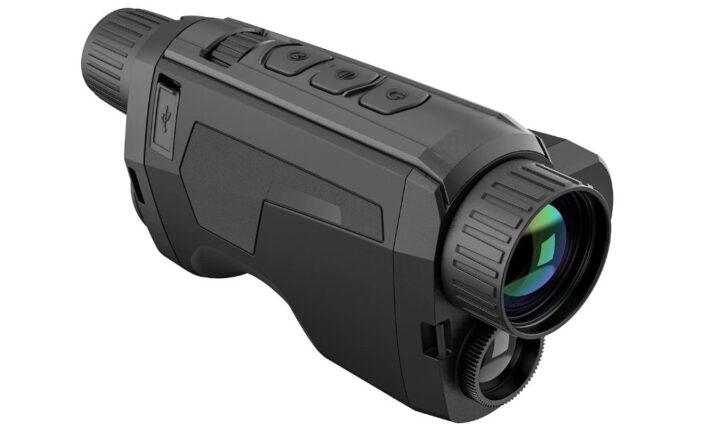Best thermal monocular with rangefinder
A thermal monocular comes in handy, in a variety of uses whether you are a hunter, outdoor enthusiast, or security professional, and because of their high price one usually aims to get the best value from the functionalities offered.
One of the most desirable features is a rangefinder in-built into the thermal monocular. A rangefinder uses different mechanisms to estimate the distance to the target and helps the user of the monocular, particularly for aiming. By combining thermal imaging technology with a rangefinder, these thermal monoculars also offer unmatched accuracy besides being able to see targets in complete darkness.
Not all thermal monoculars incorporate a rangefinder but this article reviews the best ones that do, and let’s begin.
4 Best Thermal Monocular with Rangefinder
- ATN OTS-XLT 160 2-8x
- AGM Global Vision Fuzion LRF TM35-640
- Pulsar Telos XP50 2.5-10x50mm
- Burris BTH 35 2.3-9.2x35mm
1. ATN OTS-XLT 160 2-8x Thermal Monocular
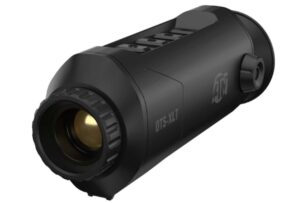
This is the cheapest monocular on this list but still manages to incorporate a rangefinder. The ATN is a brand that has built a good reputation when it comes to optics that can be used during the night and the XLT 160 2-8x is just about the cheapest of their model. What makes this monocular come at a budget-friendly price is its simplicity from how It’s built to the basic yet effective controls.
It’s compact and lightweight at just 0.81 lbs. The sensor measures 160 x 120 pixels with a 50Hz refresh rate powerful enough to detect a target at 670 yards albeit the distance of target identification is 170 yards. Despite the small numbers, the image quality is great and decently displayed on a 720 x 540 pixels microdisplay. Then different color palettes are available just to give a better thermogram when to the preference of the user.
The rangefinder we are talking about will give accurate distances up to 163 yards and according to customer reviews has proven useful many times when used for outdoor activities such as hunting, search and rescue, or patrolling. The rangefinder gives information necessary to assess the situation before further action can be taken.
Features
- Magnification: 2 – 8 x
- Resolution, 160×120 pixels
- Objective Lens Diameter 19 mm
- Field of View, 6.2 – 8.2 degrees
- Dimensions, 6.85 in x 2.63 in x 2.08 in
- Refresh Rate 50 Hz
- Detection range 670 yards Identification range 170 yards
2. AGM Global Vision Fuzion LRF TM35-640
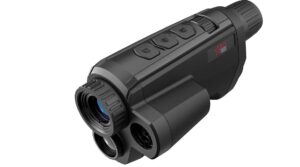
This is one of the most advanced thermal monoculars in the world. It uses a high-power sensor measuring 640 x 512 pixels for great sensitivity with the capability to detect human-sized targets up to a mile away.
It has an additional night vision channel to help recognize targets identified by the thermal sensor and all this is displayed on a crisp 0.39-inch OLED display with a 1080 x 764 resolution. The quality is further enhanced by an ultra-low illumination optical channel which fine-tunes these images under very low-light conditions.
The Fuzion LRF doesn’t only impress when it comes to sensitivity, the device is well-built and will fare well even in the most challenging weather conditions. Moreover, the robust surface can withstand all the knocks it may experience in the outdoors.
Durability is further enhanced by a capable lithium-ion battery with provision for an external power source both able to give you a remarkable duration. The laser rangefinder in the Fuzion LRF has a 905nm wavelength and can give accurate distances up to 600 meters.
Features
- Magnification 2 – 16x
- Resolution, 640 x 512 pixels
- Field of View, 12.5- 10 degrees
- Dimensions, 6.6 × 3.4 × 2.9 in
- Refresh Rate 50 Hz
- Detection range 1750 yards
- Weighs 1.15lbs.
3. Pulsar Telos XP50 2.5-10x50mm
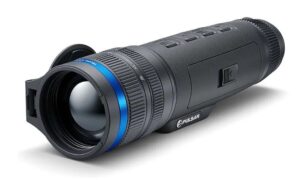
This is a thermal monocular that’s built with the future in mind, this is by including customizable features to cater for any future upgrades. The laser rangefinder in use will be able to give accurate ranging for up to 1000 yards which is a great addition to an already great thermal monocular.
The gadget is well built using a very hard polymeric rubber on the surface material that’s been proven to withstand some of the toughest conditions in existence. The manufacturer then intentionally eliminated any protruding parts on the surface for user comfort and ergonomics and to prevent any breakage after a fall.
Controls are easy to operate and can be manipulated using any hand right or left. Images gathered by the capable sensor measuring 640 x 480 are then vividly displayed on an AMOLED screen with 1024 X768 resolution. The battery will last for more than 8 hours of continuous use yet it can easily be charged wirelessly as well as via a type C outlet. Overall, this is a great option for a user who wants a future-proof monocular with a rangefinder that’s rugged and simple to use.
Features
- 2.5-10X Magnification
- Rubber armored reinforced plastic construction
- 1800 Meter thermal detection range
- 640×480 Resolution sensor
- AMOLED HD Display with 1024×768 resolution
- 64GB of built-in memory
- Weighs 0.72kg
4. Burris BTH 35 2.3-9.2x35mm
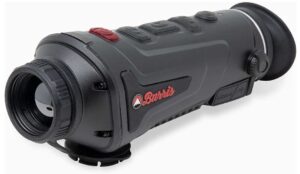
The Burris has been a popular alternative in existence for a while now. There are multiple ways one can customize it to make sure that it’s able to deliver. This includes multiple color palettes, and reticles to guarantee proper target acquisition. Moreover, there is a unique feature that allows one to track heat signatures and this can be done from over 750 yards away. All these features are enhanced by the stadiametric rangefinder that will calculate the precise distance to the target.
I would probably rank this to give an absolute value for the money that despite having a powerful sensor measuring 400 x 300, in addition to a durable battery that will be able to power it for more than 5 hours, the gadget is priced quite affordably.
It’s fairly lightweight weighing 17.1 Oz. yet durable and one will be pleased to understand that it will be able to withstand the toughest conditions out in the field.
Features
- 3 – 9.2 x magnification
- 400×300 Resolution sensor
- Objective Lens Diameter 35 mm
- Dimensions 7.5 x 2.5 x 2.7 in
- 720 yards thermal detection range
- Hot tracking of thermal signal
- Weight: 17.1 oz
What to consider when buying a thermal Monocular with a rangefinder
When selecting a thermal monocular with a rangefinder, there are several factors to consider to ensure you choose the right device for your needs. Let’s explore these factors in more detail:
Resolution
The resolution of the thermal sensor determines the level of detail and clarity in the images produced by the monocular. Higher resolutions result in sharper images, allowing for better target identification and tracking. Look for models with a higher resolution for optimal performance.
Rangefinder Accuracy
The accuracy of the rangefinder is crucial for precise distance measurements. Check for the specified accuracy of the rangefinder and ensure it meets your requirements, especially if you plan to use the monocular for long-range shooting or tactical operations.
Detection Range
The detection range refers to the maximum distance at which the thermal monocular can detect and identify targets. Consider your specific application and choose a monocular with a detection range that suits your needs. Keep in mind that the detection range may vary depending on factors such as target size and environmental conditions.
Battery Life
The battery life of a thermal monocular is important, especially for extended outdoor use. Look for models with long battery life or the option to use rechargeable batteries. Additionally, consider the availability and ease of replacing batteries in case they run out during a crucial moment.
Size and Weight
The size and weight of the monocular can impact its portability and ease of use. Consider your specific needs and preferences when choosing a size and weight that suits you. If you plan to carry the monocular for extended periods or in challenging environments, a lightweight and compact model may be more suitable.
Price
How much are you willing to spend to acquire a thermal monocular with a rangefinder? Many manufacturers have tried to strip down some features from the thermal monoculars to make them budget-friendly priced in the $400-$800 range. For someone, however, who wants full functionality and capability mostly a powerful sensor they have to opt for a more powerful yet expensive thermal monocular priced at $1000 and above
See also: Best Thermal Monocular under $1000
Additional Features
Consider any additional features that may enhance your experience or meet specific requirements. These may include image and video recording capabilities, Internal storage, Wi-Fi or Bluetooth connectivity, image stabilization, customizable reticles, and compatibility with external accessories like tripods or weapon mounts.
FAQs
How does a thermal Monocular work?
A thermal monocular detects heat radiated by an object using a thermal sensor equipped with a microbolometer. When the sensor detects heat, it converts it to an electric signal and displays it on a screen in different colors, each representing a different intensity of heat, generating an image known as a thermogram.
How does a rangefinder work?
The rangefinder emits a laser or ultrasonic wave to a target and then measures the time it takes for the wave to travel to the target and back, calculating the distance based on the speed of light or sound.
Which is the best long-range thermal monocular?
From the list of monoculars we have reviewed the best long-range monocular would be the AGM Global Vision Fuzion LRF TM35-640 capable of detecting the target at 1750 yards
Conclusion
A thermal rangefinder is a useful tool for improving visibility at night, particularly where night vision fails. Adding a rangefinder to a thermal monocular improves its capability and efficacy of use. This implies that a person using a thermal monocular with a rangefinder will have a better experience, and if they aim at a target, they will likely be more accurate. This article reviews the best of these monoculars with a rangefinder, so purchase one from the list and enjoy.
